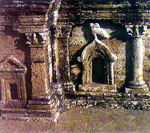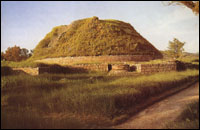|
Taxila
 The modern town of Taxila is 35 km from Islamabad. Most of the archaeological sites of Taxila (600 BC to 500 AD) are located around Taxila Museum. For over one thousand years, Taxila remained famous as a centre of learning Gandhara art of sculpture, architecture, education and Buddhism in the days of Buddhist glory. There are over 50 archaeological sites scattered in a radius of 30 kms around Taxila. The modern town of Taxila is 35 km from Islamabad. Most of the archaeological sites of Taxila (600 BC to 500 AD) are located around Taxila Museum. For over one thousand years, Taxila remained famous as a centre of learning Gandhara art of sculpture, architecture, education and Buddhism in the days of Buddhist glory. There are over 50 archaeological sites scattered in a radius of 30 kms around Taxila.
 Some of the most important sites are; Dhamarajika Stupa and Monastery (300 BC - 200 AD), Bhir Mound (600-200 BC), Sirkap (200 BC - 600 AD), Jandial Temple (c.250 BC) and Jaulian Monastery (200 - 600 AD). Some of the most important sites are; Dhamarajika Stupa and Monastery (300 BC - 200 AD), Bhir Mound (600-200 BC), Sirkap (200 BC - 600 AD), Jandial Temple (c.250 BC) and Jaulian Monastery (200 - 600 AD).
Taxila Museum
 A museum comprising various sections with rich archaeological finds of Taxila, arranged in chronological order and properly labeled, has been established close to the site. It is one of the best and well-maintained site museums of Pakistan. Summer timings of the museum are from 8:30 a.m. to 5:30 p.m. with two hours break. Winter timings are from 9:00 a.m. to 4:00 p.m., without break. The museum remains closed on the first Monday of every month and on Muslim religious holidays. Entry ticket costs Rs.4 per person for museum and Rs.4 per person for archaeological sites. A museum comprising various sections with rich archaeological finds of Taxila, arranged in chronological order and properly labeled, has been established close to the site. It is one of the best and well-maintained site museums of Pakistan. Summer timings of the museum are from 8:30 a.m. to 5:30 p.m. with two hours break. Winter timings are from 9:00 a.m. to 4:00 p.m., without break. The museum remains closed on the first Monday of every month and on Muslim religious holidays. Entry ticket costs Rs.4 per person for museum and Rs.4 per person for archaeological sites.
PTDC has a Tourist Information Centre and a Motel with 7 rooms and restaurant facility, just opposite the Museum. There is a Youth Hostel nearby, offering accommodation for members of International Youth Hostels Federation (IYHF).
Mankiala Stupa
 The remains of a Buddhist Stupa lie about 32 km south east of Rawalpindi in Mankiala village, 2 km off the G.T. Road. Apparently, this stupa was built in the reign of Kanishka (128-151 AD). According to a legend, Buddha had sacrificed parts of his body here, to feed seven hungry tiger-cubs. In 1930, several gold, silver and copper coins (660 - 730 AD) and a bronze casket having Khroshti inscriptions, were discovered from this stupa The remains of a Buddhist Stupa lie about 32 km south east of Rawalpindi in Mankiala village, 2 km off the G.T. Road. Apparently, this stupa was built in the reign of Kanishka (128-151 AD). According to a legend, Buddha had sacrificed parts of his body here, to feed seven hungry tiger-cubs. In 1930, several gold, silver and copper coins (660 - 730 AD) and a bronze casket having Khroshti inscriptions, were discovered from this stupa
Mingora:
3 kms. From Saidu Sharif, has yielded magnificent pieces of Buddhist sculpture and the ruins of great stupas. Other beauty spots worth visiting are Marghzar, 13kms. from Saidu Sharif, famous for its "Sufed Mahal" the white marble palace of the former Wali (ruler) of Swat; Kabal, 16 kms. from Saidu Sharif with its excellent golf course, Madyan, 55 kms. from Saidu Sharif, Bahrain, Miandam and Kalam.
Malam Jabba, at 2,636 metres above sea level and 45 kms. north-east of Saidu Sharif is being developed as a ski-cum-summer resort.
Swat is linked by road and air to Islamabad/Rawalpindi and Peshawar. Regular coach service for Saidu Sharif is run by Pakistan Tours Ltd. From 1st June to 30th August every year.
There are moderately priced hotels, motels and rest-houses in Swat including PTDC Motels at Saidu Sharif, Miandam and Kalam.
Rawalpindi
The materiel remained found on the site of the city of Rawalpindi prove the existance of a Buddhist establishment contemporary to Taxila but less celebrated than its neighbor does. It appears that the Ancient city went into oblivation as a result of the Hun devastation. The first Muslim endeavor, Mahmood of Ghasni (979-1030 AD) gifted the ruined city to a Ghakkar Chief, Kai Gohar. The town, however being on indavours route, could not prosper and remain deserted until Jahanda Khan, another Ghakkar Chief, resorted it and gave the name of Rawalpindi after the village Rawal in 1943 AD. Rawalpindi remained under the rule of Ghakkars till Muqrab Khan, the last Ghakkar rullar, was defeated by Sikhs in 1765 AD. Sikhs invited traders from other places to settle here. This brought the city into prominence. Sikhs lost the city to British Army and they established a contonment south of the old city. In 1879 , the Punjab northern Railway was extented to Rawalpindi but the train service was formally inagurated on January 01, 1886.
Over the years, Rawalpindi has retained its traditional flavor. However some modern residential areas and buildings have come up all over the town since the creation of Pakistan. Pakistan’s new capital, Islamabad, being the twin city of Rawalpindi, equally shares the same archaeological and history background.
Karakoram Highway
Rightly known as the eighth wonder of the world, the 804 km long Karakoram Highway starts of Mansehra and winds its precarious way along the Indus River past Thakot all the way upto the famous Khunjerab Pass at 16,100 feet above sea level, into the Pamir Plateau of the Xinjxiang Province of China. Historically known as the old ‘Silk Route’, bearing ancient Buddhist inscriptions carved into the rocks along the route, a drive on the KKH is a life time experience.
Swat
The Lush-green valley of Swat, with its rushing torrents, icy-cold lakes, fruit-laden orchards and flower-decked slopes is ideal for holiday-makers intent on relaxation. It has a rich historical past, too.
This is "Udayana" (the "Garden") of the ancient Hindu epics; "the land of enthralling beauty" where Alexander of Macedonia fought and won some of his major battles before crossing over to the plains of Pakistan. This is "the valley of the hanging chains" described by the famous Chinese pilgrim-chroniclers, Huain Tsang and Fa-Hian in the fifth and sixth centuries.
Swat was once the cradle of Buddhism of all its schools- Little Vehicle, Great Vehicle and the Esoteric sects where once 1,400 monasteries flourished. It was the home of the famous Gandhara School of Sculpture which was an expression of Graeco-Roman form in the local Buddhist tradition.
Swat was also the historical land where the Muslim conquerors, Mahmud of Ghazni, Babur and Akbar fought their battles preparatory to the conquest of the South Asia.
The ruins of great Buddhist stupas, monasteries and statues are found all over Swat.
The valley of Swat sprawls over 10,360 sq. kms at an average elevation of 975 metres. The maximum temperature in July is 38 C and minimum (during January) is 1 C. The normal temperature is maximum 21 C and minimum 7 C. The tourist season is year- round.
Giri Fort
The glen of Giri is located 8 km north-east of Taxila, at the foot of Margallah. It is approached through a rough torrent bed near two villages named Khurram Gujar and Khurram Paracha. There are remains of two monasteries and stupas, one on the top of the hill and other below it. The remains of Giri Fort are perched on the hill top, with spring water falling within it. The fort was built in 5th century by the Buddhist monks. Later, it was used by Sultan Masud, son of Sultan Mahmud of Gazni.
|

